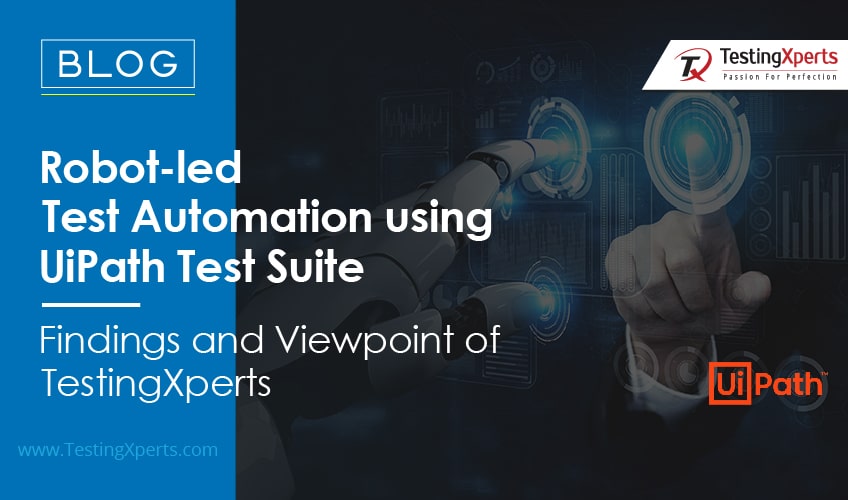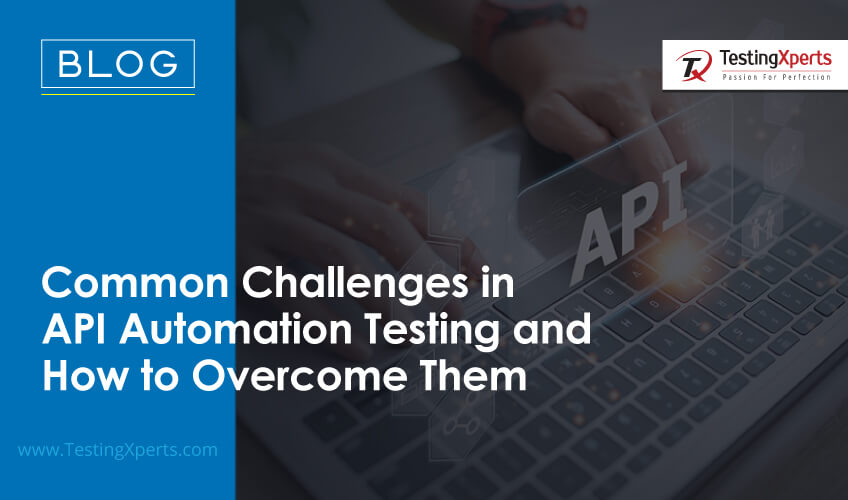
- What is API Automation Testing?
- Common API Automation Testing Challenges
- Best Practices for Implementing API Automation Testing
- Business Outcomes of Implementing API Automation Testing
- Conclusion
- How Can TestingXperts Help with API Automation Testing?
API automation testing has emerged as a critical component in the rapidly evolving software development business. It is clear from the expected rapid expansion of the API management market, which is predicted to grow by 34.42% annually. A clear example of the importance of this was seen in the healthcare industry in 2020. There, API usage increased by more than 400%, mainly due to the challenges brought on by the COVID-19 pandemic. This highlights how crucial APIs have become in meeting the rising demands in various sectors, especially in critical times.
Furthermore, 56% of enterprise leaders acknowledge that APIs are instrumental in creating enhanced digital experiences and products. In comparison, 52% agree that APIs accelerate innovation by facilitating integration and collaboration with partners. API usage is also apparent in cloud-based software companies, with APIs accounting for 50% of their revenue, fixing their role in driving technological advancement.
However, alongside these advancements, challenges like API security remain significant concerns, with 48% of fintech companies highlighting this issue. Despite these challenges, the reliance on APIs is unmistakable, as evidenced by the fact that APIs power 57% of web applications and 56% of mobile applications. This trend is further supported by a 60% growth in API developers, reaching 4.1 million in 2020, indicating a clear shift towards API-centric development in the tech industry.
What is API Automation Testing?
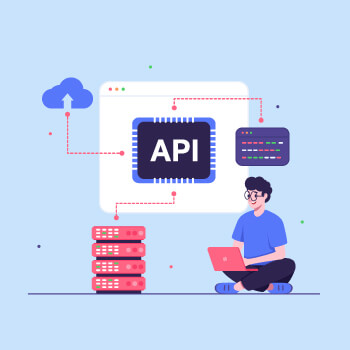
API automation testing is used in software development to check whether an application’s APIs (Application Programming Interfaces) meet functionality, reliability, performance, and security expectations. This process involves automated testing tools to send API calls, get outputs, and record the system’s response. Unlike manual testing, which requires human intervention, automation testing executes these tests automatically, saving time and ensuring accuracy.
The main goal of API automation testing is to ensure that the interface functions correctly and interacts as expected with other software systems. This includes verifying that the API handles requests and returns responses correctly, manages data effectively, and works seamlessly within the application’s ecosystem. It is an essential step in software development, especially for applications relying heavily on APIs for their functionality.
Common API Automation Testing Challenges
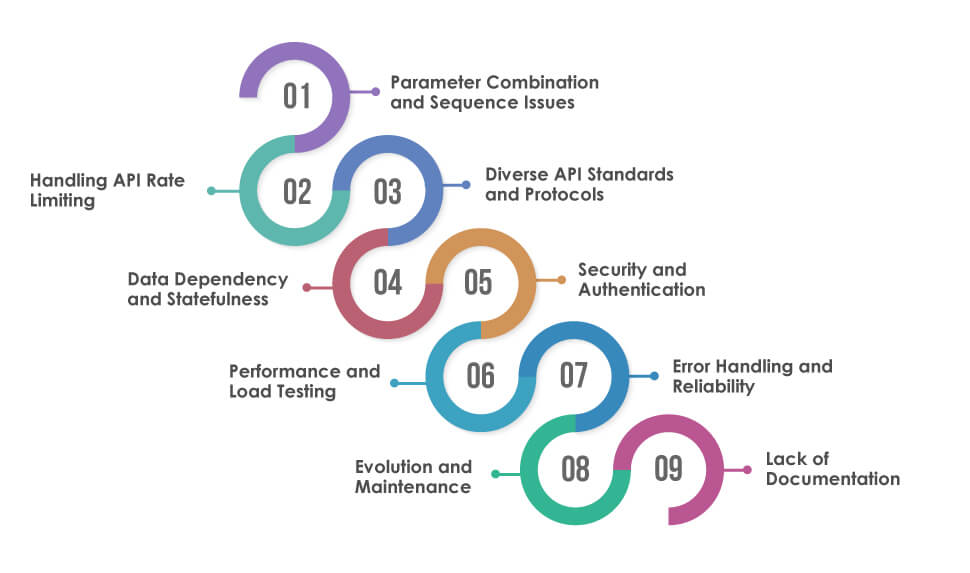
In software development, API automation testing faces several technical challenges. These challenges can impact testing processes’ efficiency, accuracy, and reliability. Understanding and addressing these challenges is crucial for successful API testing.
Parameter Combination and Sequence Issues:
APIs often require a specific sequence of operations with multiple parameters. Automating tests to validate these sequences and parameter combinations accurately is challenging. This complexity increases with the number of parameters and potential sequences, making designing tests that can effectively simulate various real-world scenarios vital.
Handling API Rate Limiting:
APIs typically impose rate limits to control traffic and ensure stability. Automated tests must recognize and respect these limits to prevent triggering false negatives, which can lead to misinterpretation of test results. This requires implementing logic in the automation framework to adapt to rate limiting, possibly by scheduling tests or dynamically adjusting call rates.
Diverse API Standards and Protocols:
With various API standards like REST, SOAP, and GraphQL, each having unique testing needs, it’s challenging to develop a universal testing strategy. REST APIs, for instance, require a different approach than SOAP APIs, especially regarding request formats, response handling, and endpoint security. Adapting automation frameworks to cater to these diverse standards is crucial for comprehensive testing.
Data Dependency and Statefulness:
Some APIs depend on specific data states to function correctly. Managing these dependencies in an automated testing environment is complex, requiring the tests to set up necessary data states before execution or handle stateful responses during runtime. This often involves intricate scripting and careful planning to ensure data consistency throughout the testing process.
Security and Authentication:
Secure communication and authentication, such as OAuth or API keys, are critical for API operations. Incorporating these security measures into automated tests adds an extra layer of complexity. Tests must be designed to authenticate correctly and verify that the API upholds security protocols under different scenarios.
Performance and Load Testing:
Evaluating API performance under high load conditions is essential but challenging. This involves creating tests that simulate heavy user traffic and data processing to assess response times, throughput, and reliability under stress. These tests should identify performance bottlenecks and ensure the API can handle the expected load.
Error Handling and Reliability:
APIs must be tested for their ability to handle erroneous inputs and unexpected conditions. This means creating automated tests that test for expected outcomes and deliberately introducing errors to evaluate the API’s error-handling capabilities and ability to return reliable, consistent responses.
Evolution and Maintenance:
As APIs evolve with new features or changes, automated tests must be regularly updated to remain relevant. This requires ongoing maintenance to ensure tests cover new functionalities and are adjusted for any changes in API behavior. It also involves version control and backward compatibility checks to ensure new changes do not break existing functionalities.
Lack of Documentation:
One significant challenge in API automation testing is the absence of comprehensive and precise documentation. This lack of proper documentation can lead to misunderstandings about the API’s functions, endpoints, and what kind of responses to expect. It makes it difficult for testers to understand the intended use and behaviors of the API, leading to less effective and efficient testing. Inadequate documentation can also hinder the creation of accurate test cases and increase the time required for understanding and testing the API.
Best Practices for Implementing API Automation Testing
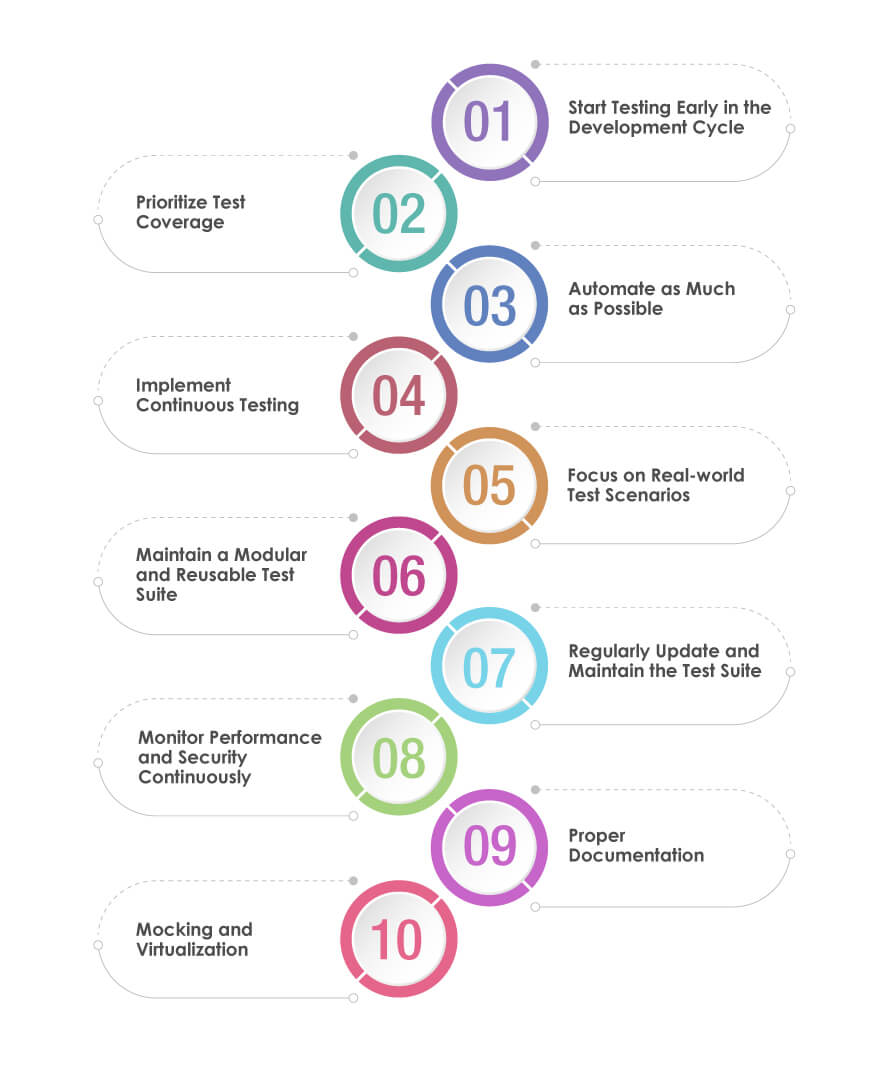
Implementing best practices in API automation testing is crucial for enhancing the efficiency and effectiveness of the testing process. These practices streamline the testing workflow and ensure the results are reliable and the APIs function as expected in different scenarios. Here are some key best practices:
Start Testing Early in the Development Cycle:
Integrating API testing early in the software development lifecycle is vital. This proactive approach allows for early detection of issues, making them easier and less costly to fix. Early testing can identify integration problems, inconsistencies in API design, and potential performance bottlenecks before they become major issues.
Prioritize Test Coverage:
Comprehensive test coverage is critical to test all aspects of the API, including various endpoints, data handling, error responses, and performance under different conditions. It’s important to ensure that the tests cover multiple scenarios, including edge cases, to fully assess the API’s robustness and reliability.
Automate as Much as Possible:
Automation is essential for efficiency and accuracy in API testing. Automating repetitive tasks like test case execution, data generation, and result logging reduces manual effort and minimizes the risk of human error. This approach also enables more frequent and consistent testing, which is crucial for maintaining high standards of API quality.
Implement Continuous Testing:
Continuous testing, integrated into the CI/CD pipeline, allows for immediate and ongoing assessment of the API’s performance as new code is merged. This practice helps quickly identify and address any issues introduced by recent changes, ensuring that the API remains stable and functional throughout development.
Focus on Real-world Test Scenarios:
Creating test cases that simulate real-world scenarios ensures that the API can handle practical use cases effectively. This includes testing under various network conditions, user loads, and different types of data input. Doing so allows businesses to better understand how the API will perform in its used environments.
Maintain a Modular and Reusable Test Suite:
Developing a modular and reusable test suite enhances efficiency. By breaking down tests into smaller, reusable components, you can easily update tests when API specifications change without having to rewrite the entire suite. This approach also facilitates more organized and manageable testing processes.
Regularly Update and Maintain the Test Suite:
Regular maintenance of the test suite is vital to cope with the ever-evolving nature of APIs. Keeping the test suite updated with the latest API changes, fixing any broken tests promptly, scripts version control, and refining tests for improved accuracy and performance are key aspects of this maintenance.
Monitor Performance and Security Continuously:
Consistent performance and security monitoring are crucial. Performance testing should evaluate the API’s response time, load handling capacity, and stability under stress. Security testing should ensure that the API is protected against common vulnerabilities and that data handling complies with relevant standards and regulations.
Proper Documentation:
Maintaining comprehensive and clear documentation is crucial for successful API automation testing. Proper documentation should detail all aspects of the API, including its endpoints, parameters, expected responses, and error codes. This not only aids testers in understanding and validating the API’s behavior but also ensures consistency and clarity across teams working on the project. Well-documented APIs facilitate smoother onboarding of new team members and contribute to more efficient testing processes.
Mocking and Virtualization:
Utilizing mocking and virtualization techniques is an effective strategy in API automation testing. Mocking involves creating a simulated API version that mimics its behavior, allowing testers to conduct tests even when the actual API is not fully developed or accessible. Virtualization goes a step further by creating a virtual environment that can emulate the real API’s network conditions, server responses, and data. These practices allow for early testing, parallel development, and handling various test scenarios without relying on the production environment. They help identify potential issues early in the development cycle, thus reducing costs and time to market.
Business Outcomes of Implementing API Automation Testing

Integrating API automation testing within a business’s development strategy marks a significant shift towards efficiency, quality, and competitiveness. This approach is not just about streamlining the testing process; it fundamentally transforms how businesses develop, deploy, and maintain their software applications. Here are the detailed outcomes:
Increased Efficiency and Productivity:
Automating API tests streamlines the testing process, allowing test scripts to run automatically and repeatedly without human intervention. This efficiency leads to shorter development cycles, enabling teams to focus on more innovative tasks. It also means that more tests can be conducted in less time, enhancing the overall productivity of the development team.
Improved Quality and Reliability:
Automated testing ensures a consistent and repeatable process, significantly reducing the chances of human error during testing. This consistency results in higher-quality APIs, as automated tests can easily detect flaws and inconsistencies. The reliability of software products improves because APIs are thoroughly tested under various scenarios, ensuring they work correctly in all situations.
Cost Reduction:
The initial setup of automated testing requires investment in tools and training. However, over time, it leads to substantial cost savings. These savings come from a reduced workforce for manual testing, a lower incidence of bugs and errors in production, and decreased downtime. Automated testing also minimizes the costs of delayed product releases and fixing bugs in live environments.
Enhanced Customer Satisfaction:
High-performing, reliable APIs lead to better user experiences. APIs that function flawlessly and handle user requests efficiently contribute to customer satisfaction. This is particularly important in today’s digital age, where user experience can significantly impact brand perception and loyalty.
Faster Time to Market:
Automated testing accelerates the testing phase of development, enabling quicker release cycles. This speed is crucial in a competitive market where delivering updates and new features rapidly can be a significant advantage. Companies can respond faster to market changes and user feedback, keeping them ahead in the race for innovation and customer satisfaction.
Better Risk Management:
Automation allows for extensive and rigorous testing, covering more scenarios, including edge cases. This comprehensive testing helps identify potential issues and risks early in the development cycle, reducing the likelihood of post-release failures. It also ensures that APIs can handle various stress conditions, safeguarding against system crashes and data breaches.
Data-Driven Insights:
Automated testing tools often come with analytics and reporting capabilities. They provide detailed logs, error reports, and performance metrics, offering insights into the API’s behavior and areas for improvement. This data is invaluable for continuous improvement and informed decision-making in the software development process.
Scalability and Flexibility:
Automated testing frameworks are designed to be scalable and adaptable. They can accommodate changes in API specifications and handle increased loads without a significant overhaul. This scalability ensures that as the business grows and its software needs evolve, the testing processes can grow and adapt accordingly without compromising quality or efficiency.
Conclusion
In conclusion, API automation testing is vital in modern software development, addressing numerous challenges such as parameter combinations, rate limiting, and diverse API standards. Best practices like early testing, comprehensive coverage, and continuous integration enhance efficiency and reliability. The business outcomes of this approach, including increased productivity, cost reduction, and improved customer satisfaction, underscore its significance. As the digital landscape continues to evolve, API automation testing remains a crucial strategy for businesses to maintain quality, agility, and competitiveness in the market. This approach optimizes technical processes and drives overall business growth and success.
How Can TestingXperts Help with API Automation Testing?

TestingXperts is a trusted API automation testing partner that offers specialized services to enhance your software development lifecycle. With an expert team and advanced tools, TestingXperts provides comprehensive API testing solutions that are efficient, reliable, and scalable.
Expertise and Experience:
TestingXperts’ team comprises highly skilled professionals specializing in API testing. Their extensive experience across various sectors allows them to understand and cater to industry-specific testing needs. This ensures that we can adeptly handle complex API testing challenges, tailoring their approach to meet the unique demands of each project.
Customized Testing Strategies:
Recognizing the unique nature of each project, we don’t rely on a one-size-fits-all approach. Instead, we develop customized testing strategies that align with your business objectives and the specific technical complexities of your project. This bespoke approach ensures a more effective and relevant testing process, directly addressing your APIs’ distinct challenges and requirements.
Advanced Tool Utilization:
At the core of TestingXperts’ approach is the use of cutting-edge automation tools and technologies. Our expertise extends to a wide range of advanced tools, which allows us to handle complex test scenarios efficiently and accurately. Using these modern tools enhances the precision of the testing process, ensuring high reliability and effectiveness in the test results.
Focus on Security and Compliance:
TestingXperts strongly emphasizes security and regulatory compliance. We incorporate security testing protocols to ensure your APIs are functional and secure against potential threats. Our testing processes are designed to ensure that APIs comply with all relevant industry standards and regulations, providing peace of mind and protecting your data and systems.
In-house Accelerators:
Our in-house accelerator, Tx-Automate, streamlines the testing process for efficiency and speed, while Tx-HyperAutomate incorporates AI and machine learning to enhance testing capabilities. This includes predictive analytics for identifying potential issues and optimizing test cases. These tools represent our commitment to leveraging technological advancements for efficient testing services.
To know more, contact our experts now.
Discover more
Get in Touch
Stay Updated
Subscribe for more info


